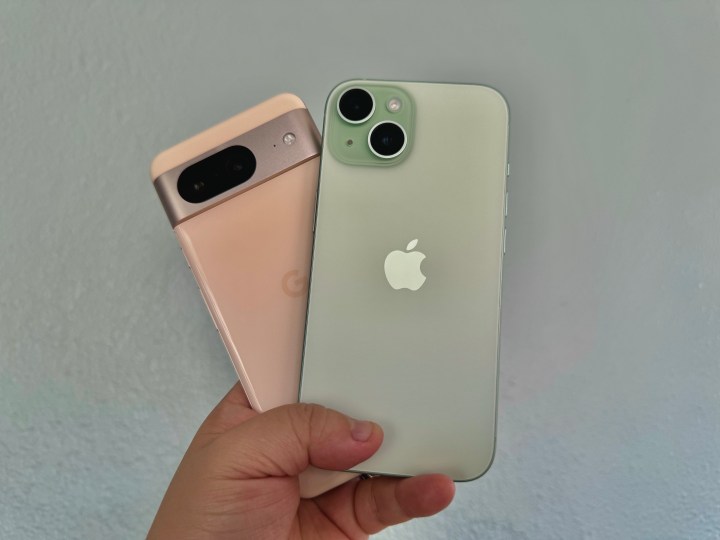
Google unveiled the Google Pixel 8 lineup at its October Made by Google event in New York. Though there aren’t any drastic upgrades to the Pixel 8, Google made some smaller changes that are sure to be welcome among fans.
- Google Pixel 8 vs. iPhone 15: specs
- Google Pixel 8 vs. iPhone 15: design
- Google Pixel 8 vs. iPhone 15: display
- Google Pixel 8 vs. iPhone 15: software and performance
- Google Pixel 8 vs. iPhone 15: cameras
- Google Pixel 8 vs. iPhone 15: battery and charging
- Google Pixel 8 vs. iPhone 15: price and availability
- Google Pixel 8 vs. iPhone 15: verdict
But Apple also released the iPhone 15 lineup in September — and it’s one of the Pixel 8’s biggest competitors. If you’re in the market for a new smartphone, which one should you pick up? The Pixel 8 and iPhone 15 are both the baseline models for Google and Apple, respectively, so let’s take a closer look at these two phones.
Google Pixel 8 vs. iPhone 15: specs
| Google Pixel 8 | Apple iPhone 15 | |
| Display | 6.2-inch LTPS OLED Actua Display
1080 x 2400 resolution at 428 ppi 1,400 nits HDR brightness, 2,000 nits peak brightness |
6.1-inch Super Retina XDR OLED Display
2556 x 1179 resolution at 460 ppi 1,600 nits HDR brightness, 2,000 nits peak brightness |
| Always-on display | Yes | No |
| Refresh rate | 120Hz – 60Hz | 60Hz |
| Colors | Obsidian, hazel, rose | Black, yellow, blue, green, pink |
| Storage and RAM | 128GB/256GB
8GB RAM |
128GB/256GB/512GB
6GB RAM |
| Processor | Tensor G3 | A16 Bionic |
| Software | Android 14 | iOS 17 |
| Rear cameras | 50MP main
12MP ultrawide |
48MP main
12MP ultrawide |
| Front camera | 10.5MP | 12MP |
| Biometrics | Under-display fingerprint sensor
Face Unlock |
Face ID |
| Battery | 4,575mAh | 3,349mAh |
| Charging | 27W wired
18W wireless with Google Pixel Stand 12W Qi-compatible wireless charging 4.5W reverse wireless |
27W wired
15W MagSafe wireless charging 7.5W Qi-compatible wireless charging 4.5W reverse wired |
| USB-C | Yes | Yes |
| Price | From $699 | From $799 |
| Available from | Google Store | Apple |
| Review | Google Pixel 8 review | Apple iPhone 15 review |
Google Pixel 8 vs. iPhone 15: design
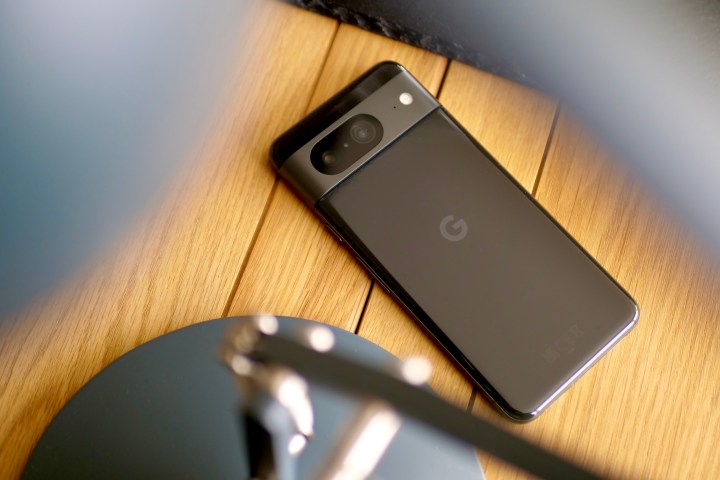
On the surface, both the Google Pixel 8 and Apple’s iPhone 15 don’t look very different from their predecessors.
The Google Pixel 8 looks very much like the Google Pixel 7 that came before it. However, there are some minor changes. The Pixel 8 now has more rounded corners and symmetrical bezels, as well as a flat display. You’ll still have the traditional camera bar on the back with the metal finish, which houses the dual camera system. Google has a new satin frame enclosure with polished back glass for the Pixel 8 (aka, the back is glossy). There are three beautiful colors for the Pixel 8: obsidian, hazel, and rose.
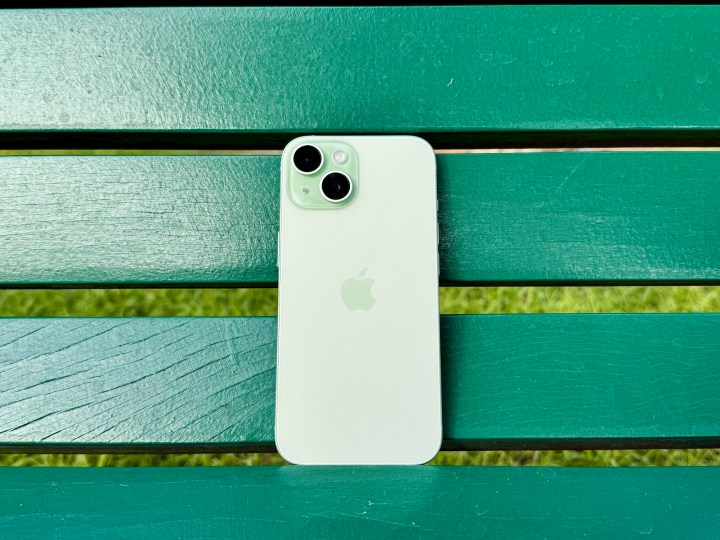
With Apple’s iPhone 15, it looks pretty similar to the iPhone 14. You still have the flat edges and diagonal dual camera layout, but that’s where the similarities mostly end. Previous base model iPhones had glossy glass on the back, but the iPhone 15 uses a new “color-infused” glass that now has a unique, matte finish. Since it’s matte, fingerprints are less likely to show up.
The iPhone 15 also has more rounded edges compared to its predecessor, which gives it a more ergonomic and comfortable feel in the hand. Apple also uses an aluminum frame that’s pretty resistant to fingerprints, and it also makes the phone quite lightweight. There are five color choices for the iPhone 15: black, yellow, blue, green, and pink. However, most of the colors are quite pale, with pink being the best of the bunch.
Both phones look great, but with more color options and a more practical matte back, we’re giving the iPhone 15 the win here.
Winner: iPhone 15
Google Pixel 8 vs. iPhone 15: display

This year, Google actually made the display on the Pixel 8 a bit smaller than before. Previously, the Pixel 7 had a 6.3-inch display, but the Pixel 8 now has a 6.2-inch Actua LTPS OLED display with a 1080 x 2400 pixel resolution at 428 pixels per inch (ppi) and a 20:9 aspect ratio.
The Pixel 8 display also has a 120Hz refresh rate and reaches an HDR brightness of 1,400 nits and a peak brightness of up to 2,000 nits. The new Actua display yields 42% brighter levels than the previous Pixel 7.
Furthermore, the Google Pixel 8 has an always-on display that features At a Glance and Now Playing. It uses Corning Gorilla Glass Victus as well.
In our review of the Pixel 8, we found the display to be bright enough to use without issue outdoors in sunshine and various angles, though it doesn’t reach the super high brightness levels of the Google Pixel 8 Pro. The display is also more flat than before, with the body of the phone blending into the screen with a curve, making it feel more comfortable to use. The screen isn’t super reflective either, and the bezels are slim. Overall, it looks great with robust color and sharpness.
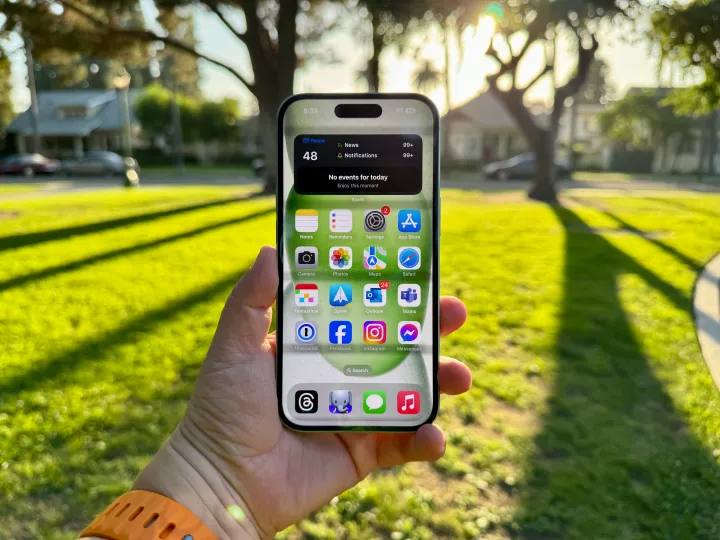
Apple’s iPhone 15 display is not quite as impressive, especially considering its price. With the iPhone 15, you have a 6.1-inch Super Retina XDR OLED display with a 1179 x 2556 resolution, 19:5:9 aspect ratio, and 461 ppi. It reaches typical brightness at 1,000 nits, but can go up to 2,000 nits peak brightness outdoors. It also brings in the Dynamic Island from last year’s iPhone 14 Pro models, making it the new standard for the iPhone.
However, even though the iPhone 15 costs more than the Pixel 8, the refresh rate is only 60Hz, which is far below what the Pixel 8 (and most Android phones, for that matter) is capable of. Though the display features bright and rich colors with sharp text, scrolling won’t be as smooth, and it’s definitely noticeable if you’re used to a higher refresh rate. It also does not support an always-on display mode, which is something the Pixel 8 does offer.
Winner: Google Pixel 8
Google Pixel 8 vs. iPhone 15: software and performance

The Google Pixel 8 ships with Android 14 out of the box, naturally. It also features Google’s new Tensor G3 chip and Titan M2 security coprocessor. The Pixel 8 also has 8GB RAM and either 128GB or 256GB of storage available.
With the Google Tensor G3, the machine learning model on the Google Pixel 8 is about 10x more complex than what was on the Google Pixel 6. Some specific features of Tensor G3 include the Pixel’s Call Screening feature that can detect and filter out spam calls, improved Clear Calling for high-definition and crystal clear phone calls, and Audio Magic Eraser, which can erase distracting sounds from your videos.
Google is also taking steps to future-proof its phones. Google is promising OS and security updates for seven years for the Pixel 8. It will also release Feature Drops, which add helpful new features for the Pixel 8, every few months.
Performance in real-world use with our review unit has been much better than the previous devices with the Tensor G2 chip. While the Pixel 8 may get warm from intensive apps and games, it never gets super hot, which was a problem with the Pixel 7 lineup. The Tensor G3 chip will be able to handle pretty much anything you throw at it, whether it’s playing games, watching video, listening to music, or just checking your email and social media. Connectivity isn’t an issue with 4G and 5G, NFC and Google Pay work flawlessly too. Overall, we’re much more impressed with the Tensor G3 than its previous iterations.

Apple’s iPhone 15 comes with iOS 17. On the inside, it has the A16 Bionic that debuted last year with the iPhone 14 Pro models and has 6GB RAM. You have the option of 128GB, 256GB, or 512GB of storage.
The A16 Bionic is quite fast in terms of performance, and iOS 17 has been a solid performer. With iOS 17, you’ll have some new features like NameDrop, improved AirDrop, Standby mode, interactive widgets, Live Voicemail, and more. It may be a smaller update than previous years, but it does add a lot of quality-of-life improvements. Apple also tends to support its devices for around six years on average, so you can expect the iPhone 15 to last a while too.
From our real world use with the iPhone 15, iOS 17 has worked well so far. The iPhone 15 doesn’t really struggle with running a lot of apps at the same time, and for the average person, it should be plenty fast. It also handles games quite well, though it may get a little warm. But the power that the iPhone 15 has is great for your daily needs.
Ultimately, which one is better really depends on whether you prefer iOS or Android overall.
Winner: Tie
Google Pixel 8 vs. iPhone 15: cameras
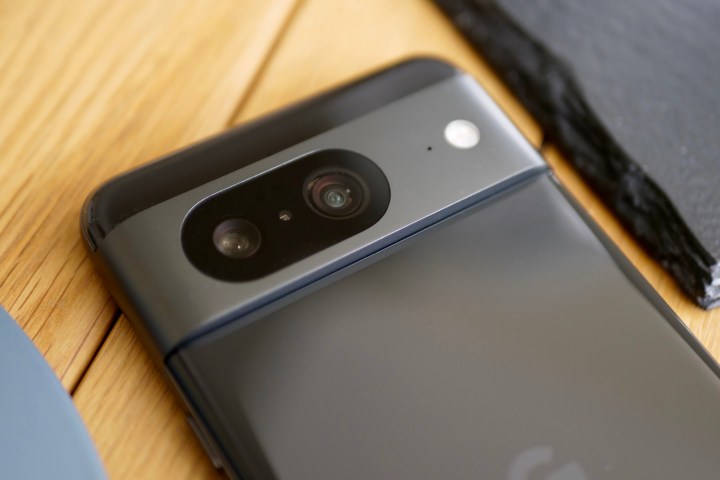
The Google Pixel 8 has a 50MP main camera and a 12MP ultrawide camera. The main camera also has an f/1.68 aperture, 82-degree field of view, and digital zoom up to 8x with optical 2x zoom. The ultrawide lens has an f/2.2 aperture and a 125.8-degree field of view. The dual camera setup has a single-zone laser detect autofocus, a spectral and flicker sensor, and optical and electronic image stabilization on the wide lens.
The selfie camera on the Pixel 8 is 10.5MP with an f/2.2 aperture, fixed focus, and 95-degree ultrawide field of view.
The rear camera should also produce some quality video. You can get 4K recording at 24/30/60 frames per second (fps) or 1080p recording at 24/30/60 fps. The front camera is capable of 4K recording at 24/30/60 fps. Google also has a macro focus video mode, cinematic blur and pan, astrophotography time-lapse, and more.
Google Pixels have had a solid reputation for taking great photos, and the Pixel 8 is no exception. The upgraded camera system with the Pixel 8 has advanced image processing that will bring out vivid colors and striking details. There is also now a new Macro Focus that lets you take even better macro images. Another new AI feature is Best Take, which will combine similar pictures into a single image where everyone looks their best, and Magic Editor, which lets you manipulate objects in a photo (like a better Magic Eraser).
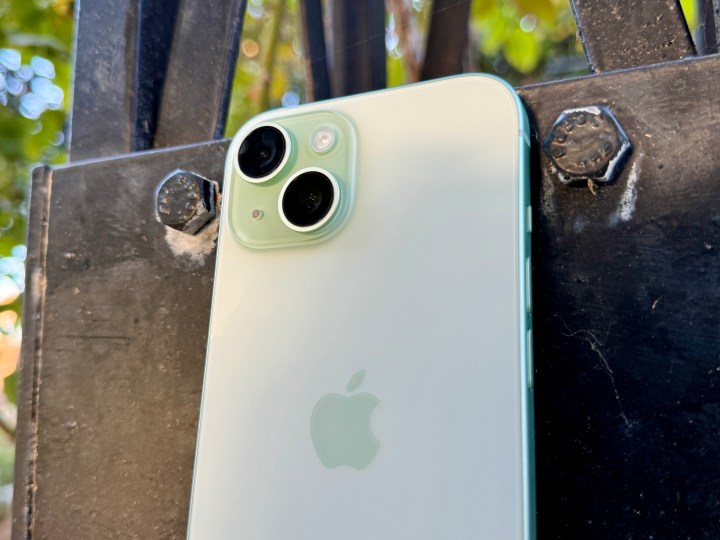
On the iPhone 15, you also have a dual camera setup with a 48MP main and 12MP ultrawide. The main camera has an f/1.6 aperture, while the ultrawide has an f/2.4 aperture. Despite not having a telephoto lens, Apple made it possible to get 2x optical zoom with up to 10x digital zoom. For the selfie camera, the iPhone 15 has a 12MP lens with an f/1.9 aperture. The selfie camera also has autofocus, which you don’t get on the Pixel 8.
Apple has made some improvements in the camera quality this year with Smart HDR 5. Colors don’t appear as harsh or washed out as in previous generations. There is also a new Auto Portrait feature for the entire iPhone 15 lineup. With Auto Portrait, as long as the camera detects a person or pet in focus, it automatically captures depth data even if you’re not in Portrait mode. When viewing the photo, you can toggle Portrait mode on or off as you please, and the feature even works for selfies too.
For video recording, Apple can be tough to beat. You have 4K recording at 24/25/30/60 fps or 1080p recording at 25/30/60 fps. The iPhone 15 also has a cinematic mode with shallow depth of field up to 4K HDR at 30 fps, HDR video recording with Dolby Vision up to 4K at 60 fps, and slo-mo video up to 1080p at 120/240 fps.
You get slightly more digital zoom and autofocus for the selfie camera on the iPhone 15. But the Pixel 8 has a slightly sharper 50MP main camera, and its AI editing tools are unmatched. Both phones take excellent photos, and they both have their own unique set of exclusive features. It ultimately comes down to what you want from your camera experience.
Winner: Tie
Google Pixel 8 vs. iPhone 15: battery and charging

The Pixel 8 has a 4,575mAh battery, and Google promises 24-hour battery life with up to 72-hour battery life with Extreme Battery Saver — the same claim it made last year for the Pixel 7. It uses USB-C for fast charging up to 27 watts, which results in a 50% charge in 30 minutes.
For wireless charging, the Pixel 8 uses Qi-compatible wireless chargers and can wirelessly charge up to 18W with the Google Pixel Stand accessory. For other wireless chargers, it will cap out at 12W speeds. You can also use the Pixel 8 to charge up other devices with Battery Share reverse wireless charging, which is around 4.5W.
Though the battery seems small, it can actually last into a second day on a single charge, depending on your usage. In our review, it was noted that our Pixel 8 lasted well into a second day with about three full hours of screen time. A heavy four hours of screen time only took about 50% of the battery, and that time consisted of games, streaming video, various apps, calls, and lots of camera use. Again, with good screen management, you could stretch that battery on the Pixel 8 to two days before you have to plug it back in. When you do plug it in, with the right charger, you’ll get about 50% charge in 30 minutes.

Apple packed in a 3,349mAh battery cell in the iPhone 15. In our tests, this should get you through the day with moderate usage. It’s an improvement over the 3,279mAh battery of the iPhone 14, but not by much.
The iPhone 15 has finally ditched Lightning for USB-C, so you no longer need a proprietary cable to charge the iPhone. However, Apple did not make any improvements to the overall charging speed, as the iPhone 15 still charges around the same 20W as before, so again, you’re looking at a 50% charge in 30 minutes.
As far as wireless charging goes, the iPhone 15 still has 15W MagSafe wireless charging speeds and 7.5W with Qi-compatible charging pads. Apple did add reverse wired charging, so as long as you have a cable, you can charge up other devices at 4.5W speed.
Winner: Google Pixel 8
Google Pixel 8 vs. iPhone 15: price and availability
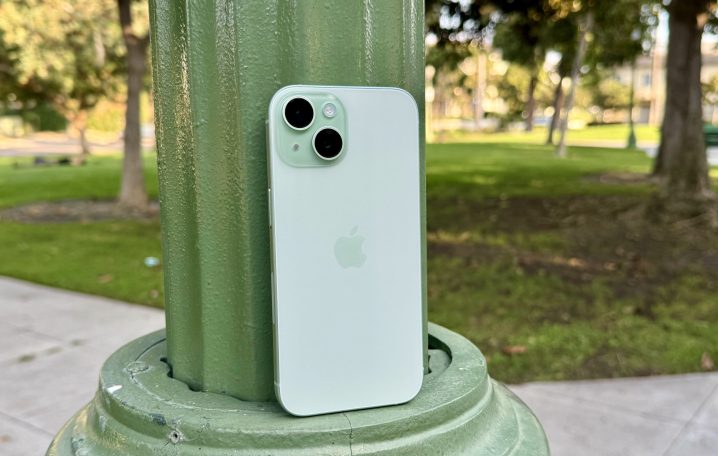
The Pixel 8 launched on October 12 and starts at $699 for the 128GB model, which is a $100 increase from the Pixel 7. Google justifies the price increase with a new design, upgraded cameras, and the Tensor G3. The Pixel 8 comes in three colors: obsidian, hazel, and rose. You can purchase it directly from the Google Store, via carrier stores, and big box retailers.
The iPhone 15 starts at $799 for the 128GB version. It comes in five colors: black, yellow, blue, green, and pink. However, most of the colors are very light and pale, though pink is a notable standout. Apple launched the iPhone 15 on September 22, and you can purchase it right now directly from Apple, carrier stores, and big box retailers.
Google Pixel 8 vs. iPhone 15: verdict

If you’re looking to get the most bang for your buck with a base model flagship, then it’s hard to beat the Google Pixel 8. For just $699, despite being more than its predecessor, you’re getting a lot more features this year.
For one, the Pixel 8 now features a 120Hz display, which is a bump up from the 90Hz of the Pixel 7. Even though it’s slightly smaller at 6.2 inches, the refresh rate is also higher, and the peak brightness is doubled. The display on the Pixel 8 is also double what Apple offers with the iPhone 15, which is only 60Hz and $100 more, which is disappointing.
Though the cameras on both phones are similar, the Pixel 8 edges out the iPhone 15 just slightly with the 50MP main shooter versus the 48MP main camera. Though the iPhone 15 does have the Auto Portrait mode, the Pixel 8 is capable of taking some great photos as well, especially with the new Best Take feature, which is especially useful if you take a lot of group photos.
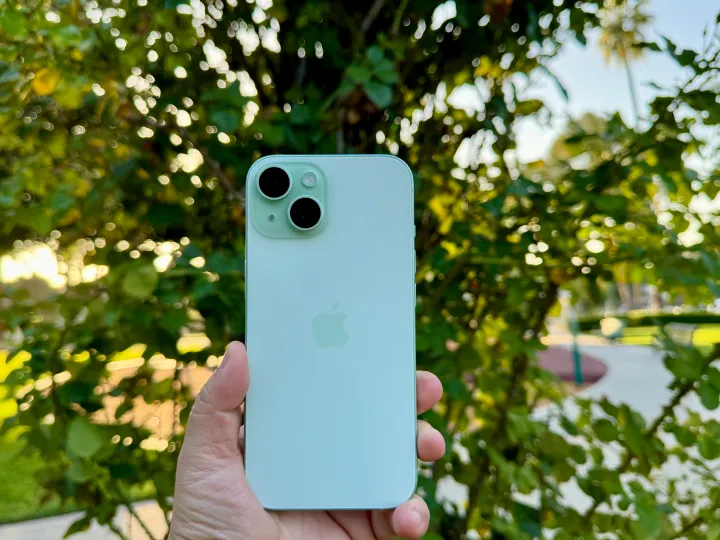
Battery life is also in the Pixel 8’s favor, offering a longer-lasting 4,575mAh battery compared to the iPhone 15’s measly 3,349mAh. Charging speeds for both phones are about the same with USB-C, but the Pixel 8 is capable of faster wireless charging overall (unless you want to use MagSafe). The Pixel 8 is also more convenient for reverse wireless charging, whereas the iPhone 15 can reverse charge, but only if you have a cable with you.
What does this all mean for you? If you know you want an iPhone, the iPhone 15 is a tough phone to beat. It’s expertly designed, very performant, and a pure joy to use. But if you want an Android handset — or you’re simply looking for the best deal possible — the Google Pixel 8 drives a pretty hard bargain.
Editors' Recommendations
- How to schedule a text message on your iPhone
- Best refurbished iPhone deals: Get an iPhone 14 for $513
- Best iPhone deals: Save on iPhone 15, iPhone 15 Pro Max and more
- iPhone 16: news, rumored price, release date, and more
- Why you should buy the iPhone 15 Pro instead of the iPhone 15 Pro Max




